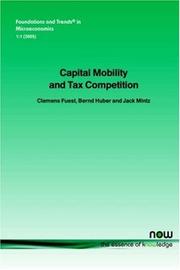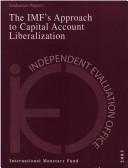| Listing 1 - 10 of 174 | << page >> |
Sort by
|
Book
Year: 2005 Publisher: Washington, D.C. : Congressional Budget Office,
Abstract | Keywords | Export | Availability | Bookmark
 Loading...
Loading...Choose an application
- Reference Manager
- EndNote
- RefWorks (Direct export to RefWorks)

ISBN: 9781933019192 1933019190 Year: 2005 Publisher: Boston: Now,
Abstract | Keywords | Export | Availability | Bookmark
 Loading...
Loading...Choose an application
- Reference Manager
- EndNote
- RefWorks (Direct export to RefWorks)
Acqui 2006 --- Taxation --- Capital movements
Book
Abstract | Keywords | Export | Availability | Bookmark
 Loading...
Loading...Choose an application
- Reference Manager
- EndNote
- RefWorks (Direct export to RefWorks)
L'aide internationale au développement apportée par le monde riche aux pays pauvres (« en développement ») représente d'importants flux de capitaux, de ressources humaines et d'assistance technique. Tandis que la direction nette de ces flux reste très controversée, on a identifié plusieurs obstacles à l'utilisation efficiente de l'aide par les pays en développement. Ils tiennent pour beaucoup aux difficultés de mise en oeuvre d'une « bonne gouvernance ». C'est pourquoi les donneurs cherchent de plus en plus à encourager la bonne gouvernance au sein des organismes destinataires de l'aide avec lesquels ils travaillent.
Economic assistance. --- Capital movements. --- Developing countries.
Book
Abstract | Keywords | Export | Availability | Bookmark
 Loading...
Loading...Choose an application
- Reference Manager
- EndNote
- RefWorks (Direct export to RefWorks)
L'aide internationale au développement apportée par le monde riche aux pays pauvres (« en développement ») représente d'importants flux de capitaux, de ressources humaines et d'assistance technique. Tandis que la direction nette de ces flux reste très controversée, on a identifié plusieurs obstacles à l'utilisation efficiente de l'aide par les pays en développement. Ils tiennent pour beaucoup aux difficultés de mise en oeuvre d'une « bonne gouvernance ». C'est pourquoi les donneurs cherchent de plus en plus à encourager la bonne gouvernance au sein des organismes destinataires de l'aide avec lesquels ils travaillent.
Economic assistance. --- Capital movements. --- Developing countries.
Book
Abstract | Keywords | Export | Availability | Bookmark
 Loading...
Loading...Choose an application
- Reference Manager
- EndNote
- RefWorks (Direct export to RefWorks)
L'aide internationale au développement apportée par le monde riche aux pays pauvres (« en développement ») représente d'importants flux de capitaux, de ressources humaines et d'assistance technique. Tandis que la direction nette de ces flux reste très controversée, on a identifié plusieurs obstacles à l'utilisation efficiente de l'aide par les pays en développement. Ils tiennent pour beaucoup aux difficultés de mise en oeuvre d'une « bonne gouvernance ». C'est pourquoi les donneurs cherchent de plus en plus à encourager la bonne gouvernance au sein des organismes destinataires de l'aide avec lesquels ils travaillent.
Economic assistance. --- Capital movements. --- Developing countries.

ISBN: 1589064151 Year: 2005 Publisher: Washington, D.C. : International Monetary Fund,
Abstract | Keywords | Export | Availability | Bookmark
 Loading...
Loading...Choose an application
- Reference Manager
- EndNote
- RefWorks (Direct export to RefWorks)
Capital movements. --- Mouvements de capitaux --- International Monetary Fund --- Evaluation.
Book
Year: 2005 Publisher: [Washington, D.C. : World Bank,
Abstract | Keywords | Export | Availability | Bookmark
 Loading...
Loading...Choose an application
- Reference Manager
- EndNote
- RefWorks (Direct export to RefWorks)
"China in the past few years has emerged as a net foreign creditor on the international scene with net foreign assets slightly greater than zero percent of wealth. This is surprising given that China is a relatively poor country with a capital-labor ratio about one-fifth the world average and one-tenth the U.S. level. The main questions that the authors address are whether it makes economic sense for China to be a net creditor and how they see China's net foreign asset position evolving over the next 20 years. They calibrate a theoretical model of international capital flows featuring diminishing returns, production risk, and sovereign risk. The calibrations for China yield a predicted net foreign asset position of -17 percent of China's wealth. The authors also estimate nonstructural cross-country regressions of determinants of net foreign assets in which China is always a significant outlier with 5 to 7 percentage points more of net foreign assets relative to wealth than is predicted by its characteristics. China's extensive capital controls can explain why its current net foreign asset position is far away from what is predicted by open-economy models and cross-country empirics. It seems reasonable to assume that China's international financial integration will increase over time. The authors calibrate and predict different scenarios out to 2025. These scenarios are necessarily speculative, but it is interesting that they typically imply negative net foreign asset positions between 3 and 9 percent of wealth. What may be counter-intuitive for many policymakers is that successful institutional reform and productivity growth are likely to lead to more negative net foreign asset positions than occurs with stagnation. Starting from China's zero net foreign assets position, it would take current account deficits in the range of 2-5 percent of GDP to reach any of these net foreign assets positions. These are not unreasonable deficits, but they require a large adjustment from the present 6 percent of GDP current account surplus. "--World Bank web site.
Alien property --- Capital movements --- Investments, Foreign --- Foreign property
Book
Year: 2005 Publisher: [Washington, D.C. : World Bank,
Abstract | Keywords | Export | Availability | Bookmark
 Loading...
Loading...Choose an application
- Reference Manager
- EndNote
- RefWorks (Direct export to RefWorks)
"China in the past few years has emerged as a net foreign creditor on the international scene with net foreign assets slightly greater than zero percent of wealth. This is surprising given that China is a relatively poor country with a capital-labor ratio about one-fifth the world average and one-tenth the U.S. level. The main questions that the authors address are whether it makes economic sense for China to be a net creditor and how they see China's net foreign asset position evolving over the next 20 years. They calibrate a theoretical model of international capital flows featuring diminishing returns, production risk, and sovereign risk. The calibrations for China yield a predicted net foreign asset position of -17 percent of China's wealth. The authors also estimate nonstructural cross-country regressions of determinants of net foreign assets in which China is always a significant outlier with 5 to 7 percentage points more of net foreign assets relative to wealth than is predicted by its characteristics. China's extensive capital controls can explain why its current net foreign asset position is far away from what is predicted by open-economy models and cross-country empirics. It seems reasonable to assume that China's international financial integration will increase over time. The authors calibrate and predict different scenarios out to 2025. These scenarios are necessarily speculative, but it is interesting that they typically imply negative net foreign asset positions between 3 and 9 percent of wealth. What may be counter-intuitive for many policymakers is that successful institutional reform and productivity growth are likely to lead to more negative net foreign asset positions than occurs with stagnation. Starting from China's zero net foreign assets position, it would take current account deficits in the range of 2-5 percent of GDP to reach any of these net foreign assets positions. These are not unreasonable deficits, but they require a large adjustment from the present 6 percent of GDP current account surplus. "--World Bank web site.
Alien property --- Capital movements --- Investments, Foreign --- Foreign property
Book
Year: 2005 Publisher: [Washington, D.C. : World Bank,
Abstract | Keywords | Export | Availability | Bookmark
 Loading...
Loading...Choose an application
- Reference Manager
- EndNote
- RefWorks (Direct export to RefWorks)
"Over the past decade the United States has experienced widening current account deficits and a steady deterioration of its net foreign asset position. During the second half of the 1990s, this deterioration was fueled by foreign investment in a booming U.S. stock market. During the first half of the 2000s, this deterioration has been fuelled by foreign purchases of rapidly increasing U.S. government debt. A somewhat surprising aspect of the current debate is that stock market movements and fiscal policy choices have been largely treated as unrelated events. Stock market movements are usually interpreted as reflecting exogenous changes in perceived or real productivity, while budget deficits are usually understood as a mainly political decision. The authors challenge this view here and develop two alternative interpretations. Both are based on the notion that a bubble (the "dot-com" bubble) has been driving the stock market, but differ in their assumptions about the interactions between this bubble and fiscal policy (the "Bush" deficits). The "benevolent" view holds that a change in investor sentiment led to the collapse of the dot-com bubble and the Bush deficits were a welfare-improving policy response to this event. The "cynical" view holds instead that the Bush deficits led to the collapse of the dot-com bubble as the new administration tried to appropriate rents from foreign investors. The authors discuss the implications of each of these views for the future evolution of the U.S. economy and, in particular, its net foreign asset position. "--World Bank web site.
Book
ISBN: 1283218089 9786613218087 1845424697 Year: 2005 Publisher: Cheltenham, U.K. ; Northampton, Mass. : Edward Elgar,
Abstract | Keywords | Export | Availability | Bookmark
 Loading...
Loading...Choose an application
- Reference Manager
- EndNote
- RefWorks (Direct export to RefWorks)
Is the international financial architecture debate over? Not according to leading experts gathered together in this impressive volume who try to identify the key trends that will fashion the international financial system in the years ahead. As history has shown, the evolution of the international monetary system is a slow process.
International finance. --- Monetary policy. --- Capital movements. --- Foreign exchange. --- Debts, External. --- Finance --- Monetary policy
| Listing 1 - 10 of 174 | << page >> |
Sort by
|

 Search
Search Feedback
Feedback About UniCat
About UniCat  Help
Help News
News